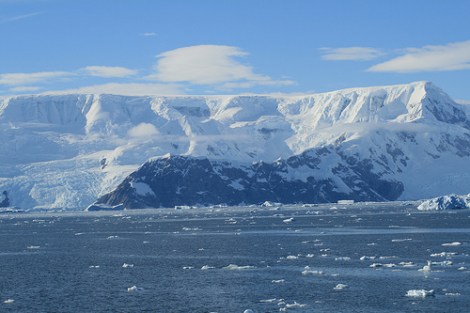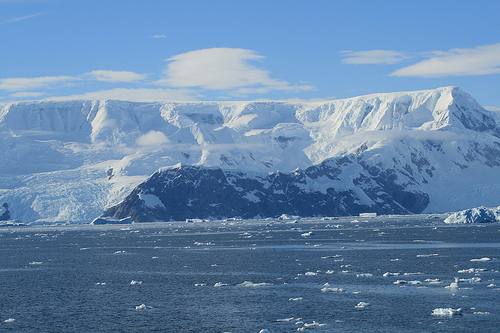As Arctic permafrost thaws, methane is released. Last December, we got the bad news that the release could be 2.5 times more than originally estimated. The more methane released, the more the global-warming impact — and the faster ice melts and ground thaws, and the more methane released.
Permafrost was primarily a concern in the Arctic, not the Antarctic. Today, bad news: The amount of methane released by a melting Antarctic may be equivalent.

The Antarctic peninsula, biding its time. (Photo by mark 217.)
The Antarctic Ice Sheet could be an overlooked but important source of methane, a potent greenhouse gas, according to a report in the August 30 issue of Nature by an international team of scientists.
That’s according to the University of California at Santa Cruz, which released the findings earlier today. In the Arctic, the gas is in the soil. In the Antarctic, it’s also in the ice itself.
The science team estimated that 50 percent of the West Antarctic Ice Sheet (1 million square kilometers) and 25 percent of the East Antarctic Ice Sheet (2.5 million square kilometers) overlies pre-glacial sedimentary basins containing about 21,000 billion metric tons of organic carbon.
“This is an immense amount of organic carbon, more than ten times the size of carbon stocks in northern permafrost regions,” [study coauthor Jemma] Wadham said. “Our laboratory experiments tell us that these sub-ice environments are also biologically active, meaning that this organic carbon is probably being metabolized to carbon dioxide and methane gas by microbes.” …
[The researchers] calculated that the potential amount of methane hydrate and free methane gas beneath the Antarctic Ice Sheet could be up to 4 billion metric tons, a similar order of magnitude to some estimates made for Arctic permafrost. The predicted shallow depth of these potential reserves also makes them more susceptible to climate forcing than other methane hydrate reserves on Earth.
So that’s 4,000,000,000 metric tons — an amount equivalent to the Arctic permafrost — of accumulated methane hydrate (an ice-like solid) and free gas under the Antarctic surface ice, along with 21,000,000,000,000 metric tons of permafrost-like sediment.
If substantial methane hydrate and gas are present beneath the Antarctic Ice Sheet, methane release during episodes of ice-sheet collapse could act as a positive feedback on global climate change during past and future ice-sheet retreat.
Cool. In some good news, prices of canned goods and survival shelters remain relatively low, for now.



